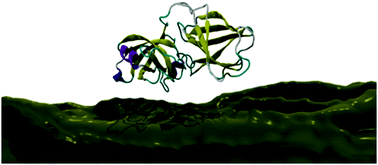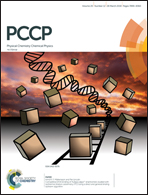On the distinct binding modes of expansin and carbohydrate-binding module proteins on crystalline and nanofibrous cellulose: implications for cellulose degradation by designer cellulosomes†
Abstract
Transformation of cellulose into monosaccharides can be achieved by hydrolysis of the cellulose chains, carried out by a special group of enzymes known as cellulases. The enzymatic mechanism of cellulases is well described, but the role of non-enzymatic components of the cellulose-degradation machinery is still poorly understood, and difficult to measure using experiments alone. In this study, we use a comprehensive set of atomistic molecular dynamics simulations to probe the molecular details of binding of the family-3a carbohydrate-binding module (CBM3a) and the bacterial expansin protein (EXLX1) to a range of cellulose substrates. Our results suggest that CBM3a behaves in a similar way on both crystalline and amorphous cellulose, whereas binding of the dual-domain expansin protein depends on the substrate crystallinity, and we relate our computed binding modes to the experimentally measured features of CBM and expansin action on cellulose.



 Please wait while we load your content...
Please wait while we load your content...